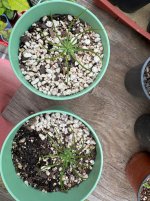Thank you everyone for all the great advice. Out of the 45 seeds I have 29 in pots/trays(no domes and outdoors) and 3 in the ground. Most of them seem to be doing good only one has a very deep curve and came out at an angle but seems to be growing just fine and looks really cool if it survives. I am grateful for these odds especially after having the seeds overwinter in horrible seed starting mix. I will keep updating you guys with photos along the way and their growth. Maybe at the end of this season I will take individual photos of them all after they have grown out a bit.
Japanese white pine (Pinus parviflora) seedlings advice.
- Thread starter Ykr
- Start date



